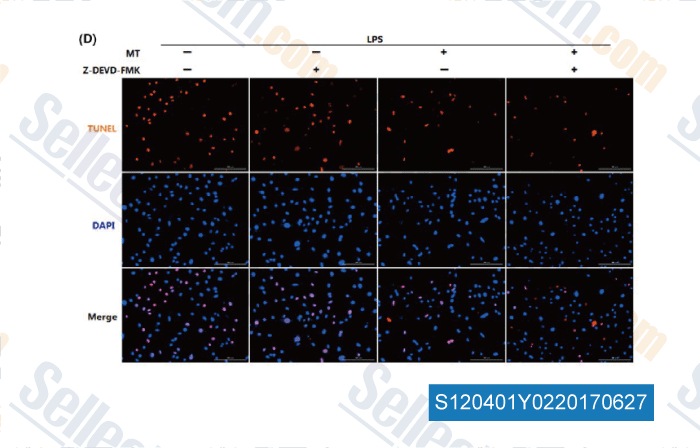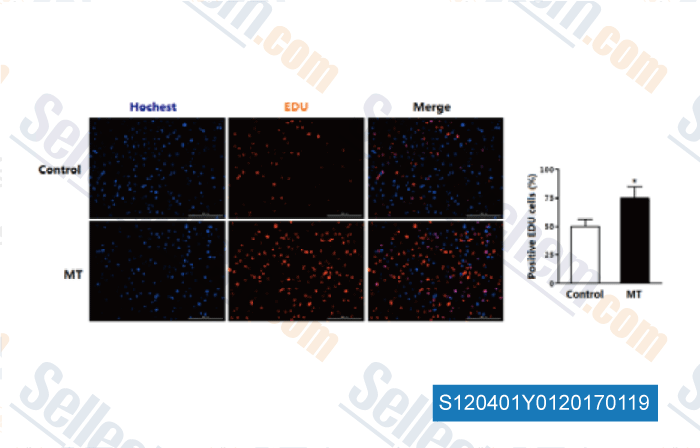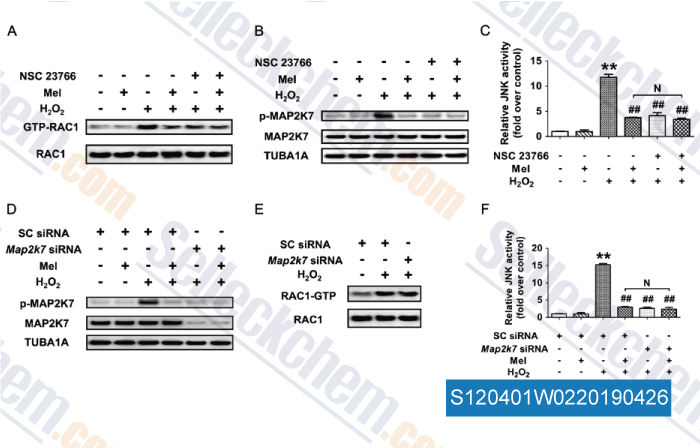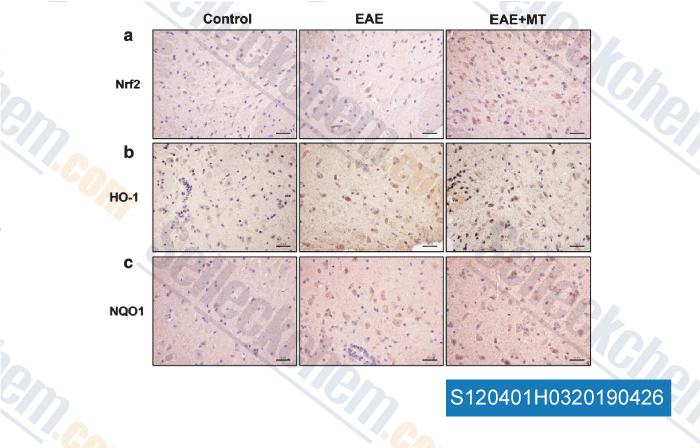|
Toll Free: (877) 796-6397 -- USA and Canada only -- |
Fax: +1-832-582-8590 Orders: +1-832-582-8158 |
Tech Support: +1-832-582-8158 Ext:3 Please provide your Order Number in the email. |
Technical Data
| Formula | C13H16N2O2 |
||||||
| Molecular Weight | 232.28 | CAS No. | 73-31-4 | ||||
| Solubility (25°C)* | In vitro | DMSO | 46 mg/mL (198.03 mM) | ||||
| Ethanol | 46 mg/mL (198.03 mM) | ||||||
| Water | Insoluble | ||||||
| In vivo (Add solvents to the product individually and in order) |
|
||||||
|
* <1 mg/ml means slightly soluble or insoluble. * Please note that Selleck tests the solubility of all compounds in-house, and the actual solubility may differ slightly from published values. This is normal and is due to slight batch-to-batch variations. * Room temperature shipping (Stability testing shows this product can be shipped without any cooling measures.) |
|||||||
Preparing Stock Solutions
Biological Activity
| Description | Melatonin is a MT receptor agonist, used as a dietary supplement. This compound is a selective ATF-6 inhibitor and downregulates COX-2. It enhances mitophagy and regulates the homeostasis of apoptosis and autophagy. | |
|---|---|---|
| Targets |
|
|
| In vitro | Melatonin interacts with the highly toxic hydroxyl radical with a rate constant equivalent to that of other highly efficient hydroxyl radical scavengers. It reportedly neutralizes hydrogen peroxide, singlet oxygen, peroxynitrite anion, nitric oxide and hypochlorous acid. [1] This compound is believed to scavenge the highly toxic hydroxyl radical, the peroxynitrite anion, and possibly the peroxyl radical. It reportedly scavenges the superoxide anion radical and it quenches singlet oxygen. The substance stimulates mRNA levels for superoxide dismutase and the activities of glutathione peroxidase, glutathione reductase and glucose-6-phosphate dehydrogenase (all of which are antioxidative enzymes), thereby increasing its antioxidative capacity. [2] This chemical in cell-free systems has been shown to directly scavenge H2O2, singlet oxygen (1O2) and nitric oxide (NO*), with little or no ability to scavenge the superoxide anion radical (O2*-) in vitro. It also directly detoxifies the peroxynitrite anion (ONOO-) and/or peroxynitrous acid (ONOOH), or the activated form of this molecule, ONOOH*. Melatonin acts as a direct free radical scavenger with the ability to detoxify both reactive oxygen and reactive nitrogen species. [3] It inhibits cAMP accumulation in most of the cells examined, but the indole effects on other messengers have been often observed only in one type of the cells or tissue, until now. This compound also regulates the transcription factors, namely, phosphorylation of cAMP-responsive element binding protein and expression of c-Fos. [4] |
|
| In vivo | Melatonin ameliorates necrotizing enterocolitis by preventing Th17/Treg imbalance through activation of the AMPK/SIRT1 pathway |
Protocol (from reference)
| Cell Assay: |
|
|---|---|
| Animal Study: |
|
References
|
Customer Product Validation

-
, , J Pineal Res. 2017, 62(4), doi: 10.1111/jpi.12383

-
Data from [ , , J Pineal Res, 2016, doi: 10.1111/jpi.12383. ]

-
Data from [ , , Reproduction, 2018, 155(3):307-319 ]

-
Data from [ , , J Mol Neurosci, 2018, 64(2):233-241 ]
Selleck's Melatonin Has Been Cited by 38 Publications
| Zearalenone Exposure Damages Skeletal Muscle Through Oxidative Stress and Is Alleviated by Glutathione, Nicotinamide Mononucleotide, and Melatonin [ Antioxidants (Basel), 2025, 14(5)528] | PubMed: 40427410 |
| Melatonin suppresses PD-L1 expression and exerts antitumor activity in hepatocellular carcinoma [ Sci Rep, 2025, 15(1):8451] | PubMed: 40069331 |
| Melatonin ameliorates ischemic brain injury in experimental stroke by regulation of miR-221 and ATG7 axis [ Biochem Biophys Res Commun, 2025, 760:151706] | PubMed: 40157291 |
| Melatonin alleviates aging-related heart failure through melatonin receptor 1A/B knockout in mice [ Heliyon, 2024, 10(18):e38098] | PubMed: 39347399 |
| Ciprofloxacin is a novel anti-ferroptotic antibiotic [ Heliyon, 2024, 10(11):e32571] | PubMed: 38961954 |
| Experimental study on small molecule combinations inducing reprogramming of rat fibroblasts into functional neurons [ Zhejiang Da Xue Xue Bao Yi Xue Ban, 2024, 53(4):498-508] | PubMed: 39183062 |
| Melatonin ameliorates glyphosate- and hard water-induced renal tubular epithelial cell senescence via PINK1-Parkin-dependent mitophagy [ Ecotoxicol Environ Saf, 2023, 255:114719] | PubMed: 37032573 |
| Melatonin attenuates chronic intermittent hypoxia-induced intestinal barrier dysfunction in mice [ Microbiol Res, 2023, 276:127480] | PubMed: 37659335 |
| Notum enhances gastric cancer stem-like cell properties through upregulation of Sox2 by PI3K/AKT signaling pathway [ Cell Oncol (Dordr), 2023, 10.1007/s13402-023-00875-w] | PubMed: 37749430 |
| Synergistic Renoprotective Effect of Melatonin and Zileuton by Inhibition of Ferroptosis via the AKT/mTOR/NRF2 Signaling in Kidney Injury and Fibrosis [ Biomol Ther (Seoul), 2023, 10.4062/biomolther.2023.062] | PubMed: 37183002 |
RETURN POLICY
Selleck Chemical’s Unconditional Return Policy ensures a smooth online shopping experience for our customers. If you are in any way unsatisfied with your purchase, you may return any item(s) within 7 days of receiving it. In the event of product quality issues, either protocol related or product related problems, you may return any item(s) within 365 days from the original purchase date. Please follow the instructions below when returning products.
SHIPPING AND STORAGE
Selleck products are transported at room temperature. If you receive the product at room temperature, please rest assured, the Selleck Quality Inspection Department has conducted experiments to verify that the normal temperature placement of one month will not affect the biological activity of powder products. After collecting, please store the product according to the requirements described in the datasheet. Most Selleck products are stable under the recommended conditions.
NOT FOR HUMAN, VETERINARY DIAGNOSTIC OR THERAPEUTIC USE.
